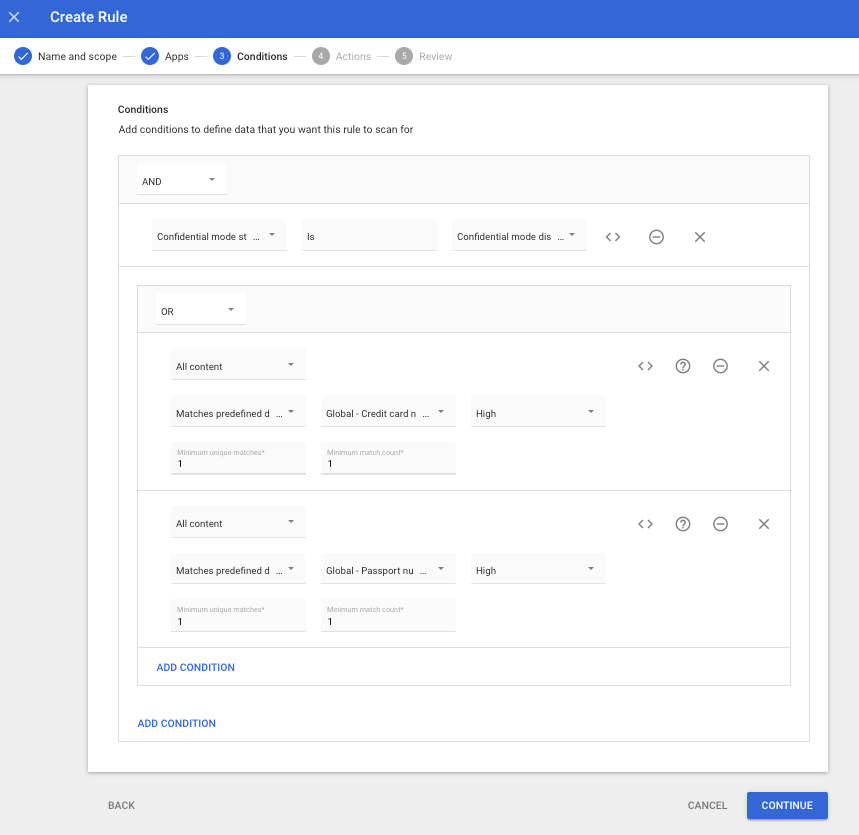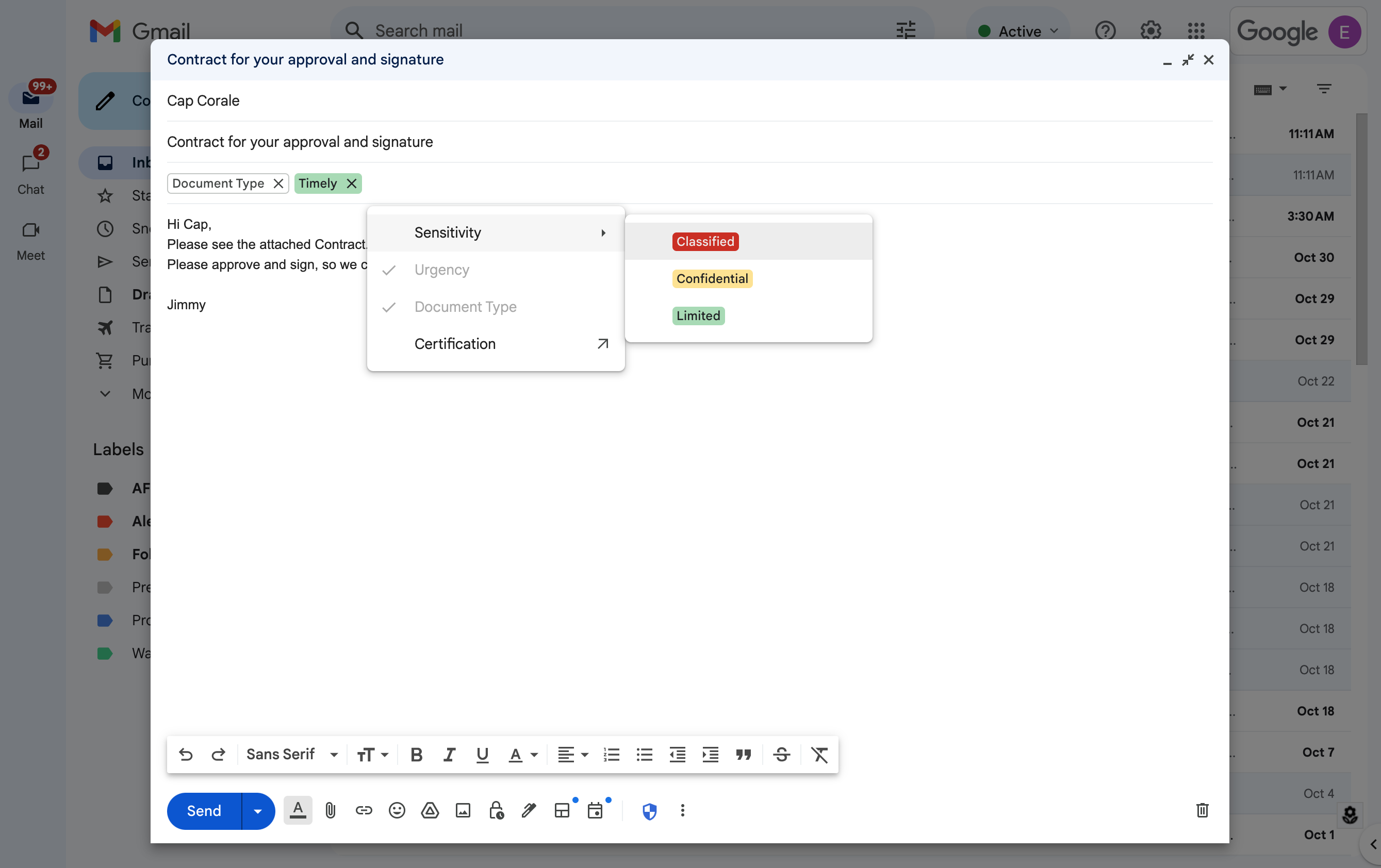von | Nov. 1, 2024 | Nachrichten
Was sich ändert
In addition to Google Drive, we’re expanding data classification labels to now include Gmail. Classification labels are used to classify and audit content according to organizational guidelines (“Sensitive”, “Confidential”, etc.) and apply policies, such as Regeln zum Schutz vor Datenverlust (DLP), to protect sensitive information in email messages. Classification labels will be available when using Gmail on the web – support for Gmail on mobile devices will be introduced in the coming months.
Wer ist davon betroffen?
Admins und Endnutzer
Warum es wichtig ist
Data breaches are increasingly common and costly across all sectors, including enterprises, public sectors, and government institutions. To minimize data exfiltration and better understand the data being shared, organizations need to differentiate between various types of information and their sensitivity levels to apply data protection policies accordingly. By expanding data classification labels to Gmail, Google Workspace provides admins with a more flexible and robust system integrated with data protection capabilities to help organizations effectively categorize and protect sensitive information.
Specifically, admins can create:
- New classification labels or extend existing ones enabled in Drive labels for Gmail from the Label-Manager. Labels can be used to denote department names, document types, document status, and other custom categories.
The Label Manager tool can be accessed in the Admin console by going to Security > Access and data control
- Data protection rules with classification label as a condition, to apply actions to a message based on its classification. For example, a message will be blocked if it’s classified as ‘Internal’ and is being sent to an external recipient.
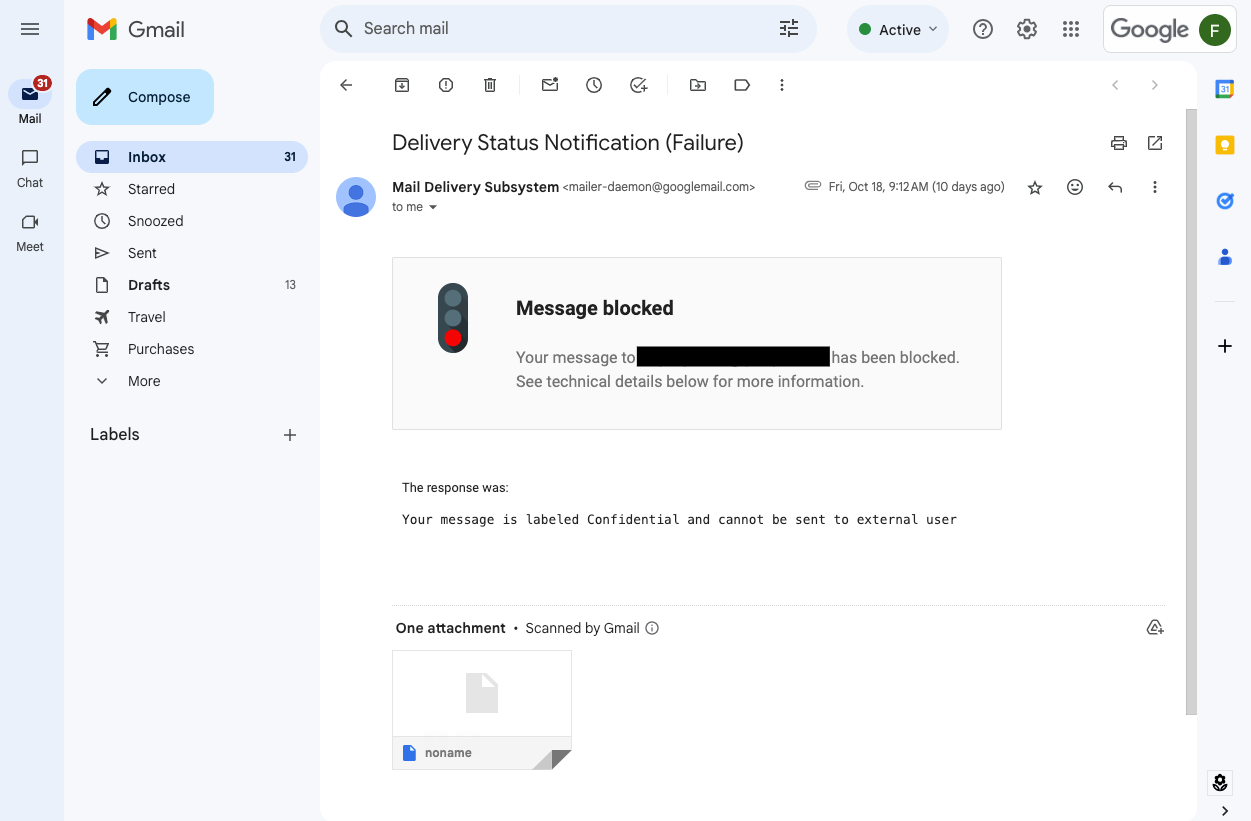
Notification about delivery failure due to DLP policy, blocking messages labeled as ‘Confidential’ to be sent to recipients outside of the organization
- Data protection rules to automatically apply classification labels to a message, based on its content. For example, a ‘Confidential’ label can be applied to a message if it contains sensitive financial information, such as credit card or bank account numbers.
Data protection rule with ‘Apply a label’ action. Classification label specified in the rule will be applied to a message, if message contains information matching conditions of the rule
- DLP rules with Confidential Mode as a condition to prevent sending messages with sensitive information, if it is not encrypted (Confidential Mode is not enabled)
Data protection rule is set up to detect messages with sensitive information (credit card or passport numbers) and confidential mode disabled in order to enforce sending such info with enhanced protection measures
- Endverbraucher can view and apply Classification Labels when using Gmail on the web.
Users can apply classification labels to a message, according to the organization’s data governance policies
Zusätzliche Details
- When Data loss prevention (DLP) rules for Gmail using classification labels either as a condition or as an action, messages are scanned asynchronously. This means that the message is classified, blocked or quarantined after it leaves the sender’s mailbox) and before being dispatched to the recipient. In a future release, we plan to provide synchronous support with instant notifications consistent with our synchronous support of instant DLP enforcement for Gmail.
- If the message is blocked as a result of the classification label applied to it, the sender will get a bounce back message.
- If the message is automatically labeled by a DLP rule, the sender will not see the label reflected in the sent message. The recipient will see the automatically applied label the same way as any other classification label applied manually by the sender.
- Only Badged options list and Multiple Options list (Single select) field types are supported in Gmail. If classification labels are enabled for usage in both Gmail and Drive, and it contains fields that are not supported in Gmail, such as date or persona, Gmail users will see the label only with fields of the supported types.
Erste Schritte
- Admins:
- Endverbraucher: If configured by your admin, you’ll see the “Classification” option when composing a new messaging or replying to an existing message — when you open the menu, you can select labels relevant to your message. We’ll share the end user Help Center article on Monday, November 3, 2024.
Tempo der Einführung
Verfügbarkeit
- The Label Manager and manual classification is available to Google Workspace:
- Frontline Starter and Standard
- Business Standard and Plus
- Enterprise Standard and Plus
- Education Standard and Education Plus
- Essentials, Enterprise Essentials, and Enterprise Essentials Plus
- Data loss prevention rules with labels as a condition or labels as an action are available to:
- Enterprise Standard and Plus
- Education Fundamentals, Standard, Plus und das Teaching & Learning Upgrade
- Frontline Standard
- Cloud Identity Premium (in combination with a Workspace Edition eligible for Gmail)
Ressourcen
von | Nov. 1, 2024 | Nachrichten
Was sich ändert
For the last few months, users with the
Gemini for Google Workspace add-ons and Gemini Education add-ons have used Gemini in the
side panel of Gmail, Docs, Sheets, Slides, and Drive to assist them with summarizing, analyzing, and generating content through insights gathered from their emails, documents, and more. Earlier this month, Gemini add-on subscribers began using Gemini in Google Chat for
summaries of unread conversations in the home view.
Today, we’re expanding Gemini in Chat to help users collaborate more effectively in their spaces, group messages and direct messages. With Gemini in the side panel of Chat, you can:
- Summarize a space or conversation. Examples include asking Gemini the following:
- “Summarize this conversation.”
- “What are the key takeaways in this conversation?”
- After an initial summary is generated, you can ask for a longer summary, “Give me a detailed summary of [topic] discussed in this space.”
- Generate a list of action items from that space or conversation, such as:
- “What are the action items in this conversation?”
- “Are there any action items for me in this conversation?”
- “Summarize [person’s] action items in this space”
- Answer specific questions about that space or conversation by asking:
- “What did [person] say about the timeline extension in this space?”
- “What’s the decision on the project discussed in this conversation?”
Wer ist davon betroffen?
Endverbraucher
Warum Sie es verwenden sollten
Gemini in the side panel of Chat enables you to better collaborate with your team by helping you quickly catch up on missed conversations, capture action items, or search for key details that are easy to miss in a fast-moving space.
Zusätzliche Details
At this time, Gemini in the side panel of Chat can summarize and analyze messages in the conversation that you are currently viewing. It will not summarize or analyze context across your entire Chat conversation history, your Gmail inbox or your Drive files.
Erste Schritte
Tempo der Einführung
Verfügbarkeit
Available for Google Workspace customers with a:
- Zwillinge Business and Enterprise add-on
- Zwillinge Education and Education Premium add-on
Ressourcen
von | Nov. 1, 2024 | Nachrichten
Was sich ändert
As recently
angekündigt, we submitted our package to obtain FedRAMP High authorization for Gemini for Workspace, including the Gemini app. A FedRAMP High certification assures federal agencies in the United States that a cloud service provides the highest level of protection for their most sensitive data, enabling them to confidently leverage cloud technologies for critical operations.
Zusätzliche Details
- Our current FedRAMP submission does not include Data Location. We’re targeting FedRAMP High with Data Location at a later date.
- The package is pending review by the Joint Authorization Board (JAB), who does not provide guidance on review timelines. Refer to the FedRAMP compliance page to view a copy of our submission.
Verfügbarkeit
Verfügbar für Google Workspace-Kunden mit diesen Add-Ons:
- Zwillinge Business
- Gemini Unternehmen
- Gemini Education
- Gemini Education Premium
Available for Google Workspace customers accessing the Gemini app as a core service with these editions:
- Business Starter, Business Standard, Business Plus
- Enterprise Starter, Enterprise Standard, Enterprise Plus
- Frontline Starter, Frontline Standard
- Essentials, Enterprise Essentials, Enterprise Essentials Plus
- Google Workspace for Nonprofits
- Education Standard, Education Plus
von | Okt. 31, 2024 | Nachrichten
Was sich ändert
We’re making it easier to apply context-aware access (CAA) policies with new insights and recommendations. We’ll proactively surface potential security gaps and suggest pre-built CAA levels which admins can deploy to remediate the security gaps. These insights will be surfaced to customers, if they have not deployed any CAA policies to their users. When you deploy a recommendation, it will first be placed in Monitor Mode, so you can understand how the policy will block user access over time, and can be reviewed in the CAA audit logs.
With this release, we’ve also added the ability for admins to customize the recommendations as they see fit before they’re applied broadly. Additionally, we’ll send primary admins an email on a quarterly basis with insights and actionable recommendations.
Wer ist davon betroffen?
Admins
Warum es wichtig ist
Using Context-Aware Access, admins can set up different access levels based on a user’s identity and the context of the request (location, device security status, IP address). This can help provide granular access controls without the need for a VPN, and give users access to Google Workspace resources based on organizational policies. Insights and recommendations help admins improve the cybersecurity posture of their organization by proactively identifying areas that need attention, significantly reducing the need for admins to identify these risks themselves. For example, if we detect devices with outdated operating system versions accessing corporate Workspace data, we can surface this as an Insight & pair it with a recommendation to block such devices from accessing Workspace data with a few clicks.
Erste Schritte
- Endverbraucher: There is no end user impact or action required.
Tempo der Einführung
Verfügbarkeit
Verfügbar für Google Workspace
- Unternehmen Standard and Plus
- Education Standard and Plus
- Unternehmen Essentials Plus
- Also available to Cloud Identity Premium customers
Ressourcen
von | Okt. 7, 2024 | Nachrichten
Was sich ändert
To add to the list of
question types that users can respond to in Google Forms and enable the collection of feedback in a more engaging way, we’re introducing a rating question type.
This new question type enables you to customize rating questions by setting a rating scale level and include rating icons, such as stars or hearts, to offer a more intuitive way to gather opinions from an audience.
With this update, you’ll be able to analyze responses to these questions (e.g. average rating of responses and visual distributions of ratings) using the summary tab of the responses section.
Erste Schritte
Admins: There is no admin control for this feature.End users: Go to “create a new form” at
forms.google.com or an existing form and add a new “Rating” question from the dropdown of different question types. Add the scale for the rating question, such as 1-5, and choose between the different icons supported: stars, hearts and thumbs up. Visit the Help Center to learn more about
asking responders to provide a rating on a scale. Tempo der Einführung
Verfügbarkeit
Verfügbar für alle Google Workspace-Kunden, Workspace-Einzelabonnenten und Nutzer mit persönlichen Google-Konten
Ressourcen

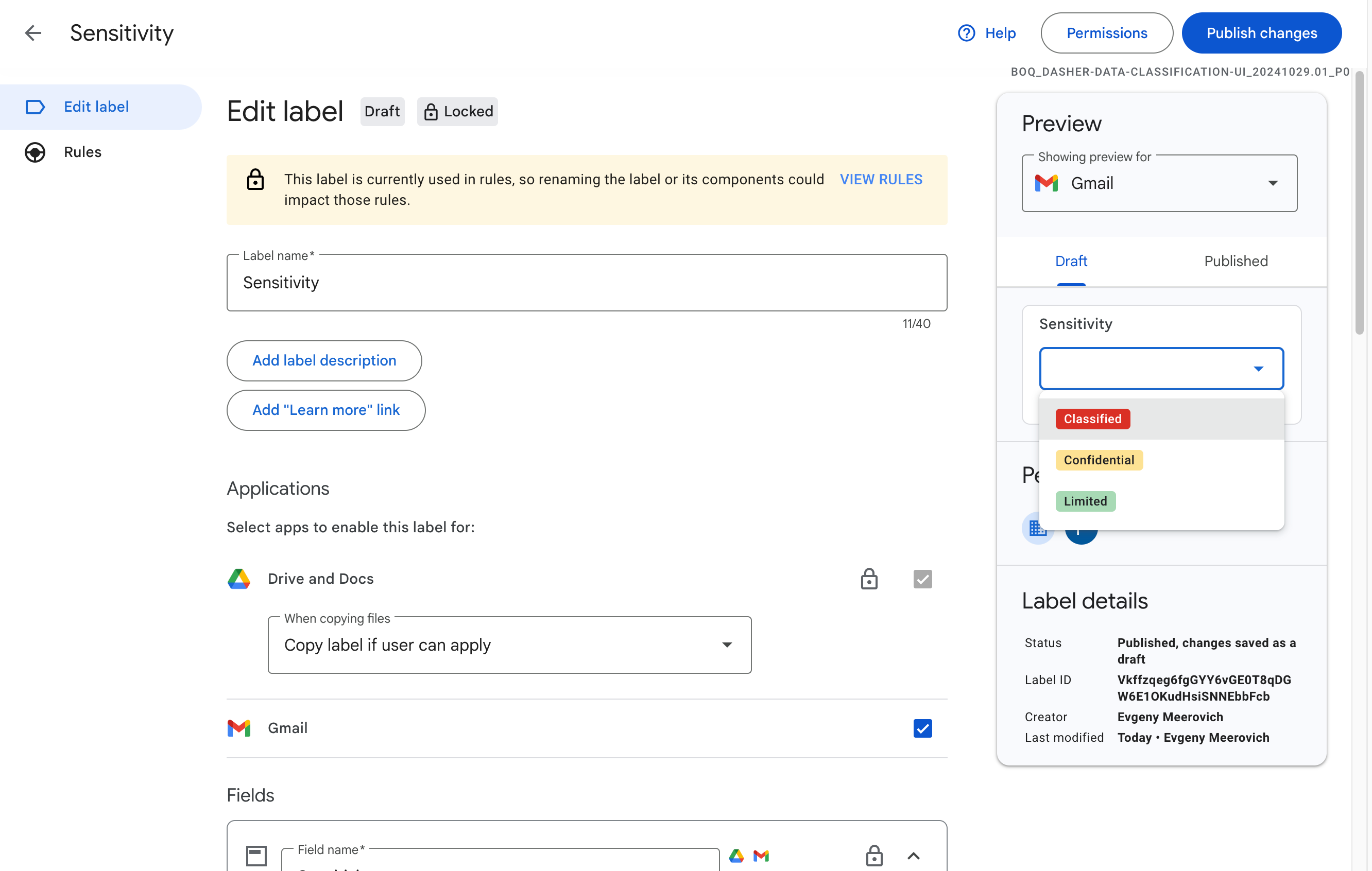

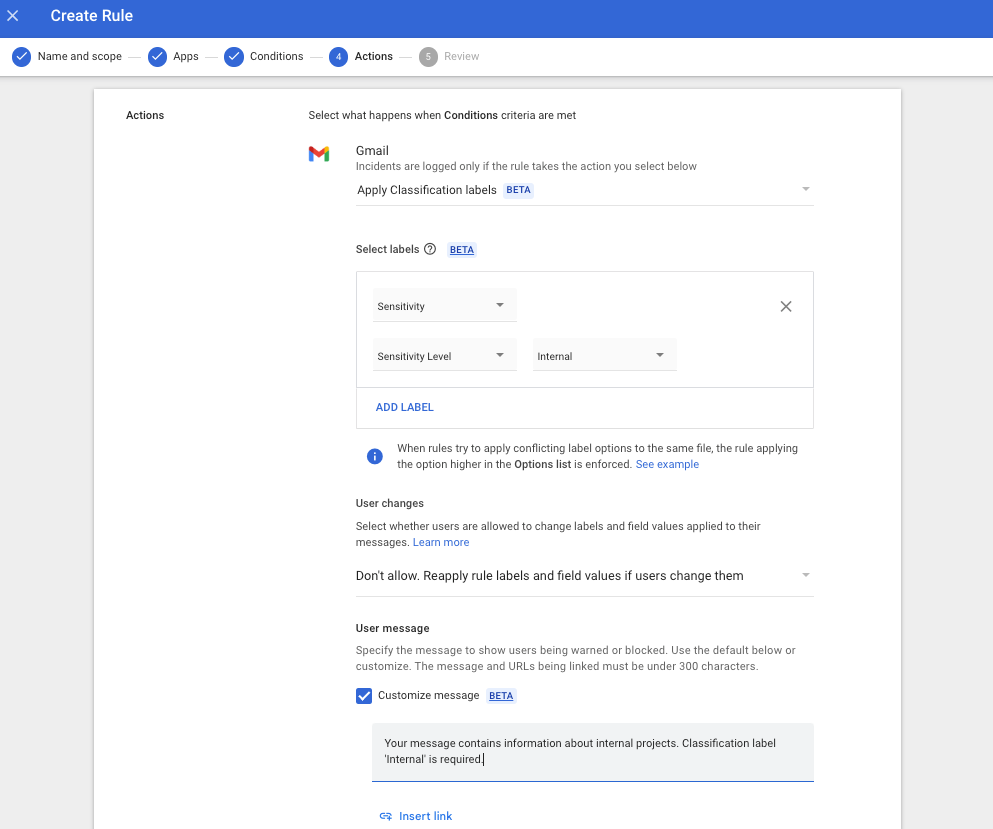.png)
